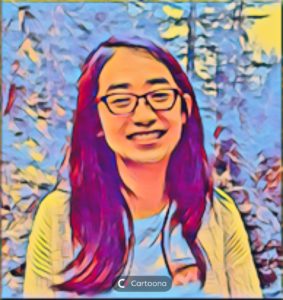Timm! Again, I am writing this for the third time, but I love how you gave a clear definition of the term equity before beginning your blog. I am starting to realize that I should have done this as well! Thank you for adding in the  “Cultivating Equity in the Classroom” video, I have always loved these simple draw-as -I-teach videos because it is the pure definition of multimodal. I cannot believe how skilled you have got in creating these beautiful informational images the graphics you chose were perfect and so pleasing to the eye. I can say that I agree that when I first began this course, I too thought that design principles and design theories would all be very different regardless of if the classes were face-to-face or online, but maybe they are not. There are specific characteristics in both scenarios that if were not made would create utter chaos and inequitable classroom, however, in the end, a teacher’s job is all the same to create a learning environment fit to each student’s individuals needs.
“Cultivating Equity in the Classroom” video, I have always loved these simple draw-as -I-teach videos because it is the pure definition of multimodal. I cannot believe how skilled you have got in creating these beautiful informational images the graphics you chose were perfect and so pleasing to the eye. I can say that I agree that when I first began this course, I too thought that design principles and design theories would all be very different regardless of if the classes were face-to-face or online, but maybe they are not. There are specific characteristics in both scenarios that if were not made would create utter chaos and inequitable classroom, however, in the end, a teacher’s job is all the same to create a learning environment fit to each student’s individuals needs.

Josh! What a brilliant idea actually giving an equity definition in the intro to your blog! It truly gives the reader a sense of where the blog is going and what we should be looking for in your writing. I can say with honestly how much I appreciate the graphic you chose to help your definition. This image has always been a concrete difference for me when comparing equity and equality (it is also a great image for students). I agree with your opinion wholeheartedly on how to create an equitable classroom and love how concisely you exampled your topic reading findings. I believe that it is important to the point you admitted about it is the teacher’s decision of how to create a learning environment, however, in the end, it should always come down to what is best for the students.

Leona! I love your version of the definition of equity in education. I think that it is important to note that there are differences when it comes to equity in various situations. I cannot say enough. how much you help us as readers hyperlinking all your resources! It is a perfect example of how we can use interactive and multimedia learning in all our classes. I love how you included the design principles as well from the Kral & Schwab reading. I found that reading to be easily the most insightful to me and truly opened my mind to the possibilities that can come from making learning spaces that provide equity for all learners. As per-usual great blog, and wonderful use of combining all the readings together to make one beautiful summary.
 Josh, I got to say your blogs are so aesthetically pleasing to look at, and I cannot believe you made that graphic on your own, its true art. I couldn’t agree more with your beginning statement, I to did not realize just how long eLearning, distance education, and online/blended education has been around in the K-12 context. It is pretty incredible to think that even back when there weren’t the same technological advances as today, teachers were still thinking of the best way to help their long-distance students to learn (teachers have been caring since day 1). It’s pretty incredible to think how far Canada has advanced from the brick and mortar classroom in only the past century, and it’s even more exciting to think how much further we can go. This; was a great blog Josh and, I am 100% going to steal your timeline.
Josh, I got to say your blogs are so aesthetically pleasing to look at, and I cannot believe you made that graphic on your own, its true art. I couldn’t agree more with your beginning statement, I to did not realize just how long eLearning, distance education, and online/blended education has been around in the K-12 context. It is pretty incredible to think that even back when there weren’t the same technological advances as today, teachers were still thinking of the best way to help their long-distance students to learn (teachers have been caring since day 1). It’s pretty incredible to think how far Canada has advanced from the brick and mortar classroom in only the past century, and it’s even more exciting to think how much further we can go. This; was a great blog Josh and, I am 100% going to steal your timeline. ave re-learned this topic in a summarized form (which I guess is the point)! I love how you gave definitions of each of the learning theories and, now I am thinking for my next blog I may do the same! I really wish I could have experienced the live webinar with Dr. Barbour, Dr. LaBonte, and Dr. Roberts because I can only imagine how meaningful it was to this topic. However, I can’t agree more with your statement about “intention.” I feel that in the day and age where technology is seeming to take over our lives and teachers are getting frustrated too often thinking they are losing control over how they teach. I saw this happen to my dad when one of his favourite classroom year-end project had to be canceled because to him “it wasn’t possible with the technology they had access with” however like you said, “Ultimately, the technology you decide to use shouldn’t be the factor driving learning – it should be lead by you and your pedagogy.” (You)
ave re-learned this topic in a summarized form (which I guess is the point)! I love how you gave definitions of each of the learning theories and, now I am thinking for my next blog I may do the same! I really wish I could have experienced the live webinar with Dr. Barbour, Dr. LaBonte, and Dr. Roberts because I can only imagine how meaningful it was to this topic. However, I can’t agree more with your statement about “intention.” I feel that in the day and age where technology is seeming to take over our lives and teachers are getting frustrated too often thinking they are losing control over how they teach. I saw this happen to my dad when one of his favourite classroom year-end project had to be canceled because to him “it wasn’t possible with the technology they had access with” however like you said, “Ultimately, the technology you decide to use shouldn’t be the factor driving learning – it should be lead by you and your pedagogy.” (You) HOLY Timm! I literally thought you had taken this feature image straight out of an education magazine, very impressive technological artwork skills! As discussed before in our annotations, I grew up in the K-12 system feeling the same way about online and distributed learning as being a “alternative” route or a “last chance” for students trying to get their diploma. It is an interesting point you make about “being surprised by the lack of digital technology used in elementary schools” because in some ways I can totally see where you are coming from. With the unlimited knowledge and resources online tools and technology gives us it seems like a privileged waste to not be using them in our schools. I remember distinctly your comment in our annotations about Bates saying that past learning theories are being made irrelevant by digital technology, and I couldn’t help but agree with your statement about 1. Disagreeing with the comment and 2. Arguing the fact that there is an element of fear that is involved in this thought.
HOLY Timm! I literally thought you had taken this feature image straight out of an education magazine, very impressive technological artwork skills! As discussed before in our annotations, I grew up in the K-12 system feeling the same way about online and distributed learning as being a “alternative” route or a “last chance” for students trying to get their diploma. It is an interesting point you make about “being surprised by the lack of digital technology used in elementary schools” because in some ways I can totally see where you are coming from. With the unlimited knowledge and resources online tools and technology gives us it seems like a privileged waste to not be using them in our schools. I remember distinctly your comment in our annotations about Bates saying that past learning theories are being made irrelevant by digital technology, and I couldn’t help but agree with your statement about 1. Disagreeing with the comment and 2. Arguing the fact that there is an element of fear that is involved in this thought. After reading just the introduction to your post, you made me realize that I knew so much more about the importance of relationships amongst humans Leona! I must have completely sidestepped all my memories and knowledge of Dr. Martin Brokenleg’s Circle of Courage and Alan McLean’s 3 A’s of Motivation while conjuring up this post but thanks to your words I can now see and understand just how relevant all of these different learning models are to the topic of human-centered learning in online and open learning contexts. I enjoyed your comment about building a strong sense of community is important to learning regardless of the teaching method, I think that this statement is so important in this day and age where online classes are now the norm of our education. A teacher’s goal should not be about just passing on the content and knowledge in the simplest means possible but instead should be about creating a universally fit classroom community where knowledge and content come easily based on the relationships built within.
After reading just the introduction to your post, you made me realize that I knew so much more about the importance of relationships amongst humans Leona! I must have completely sidestepped all my memories and knowledge of Dr. Martin Brokenleg’s Circle of Courage and Alan McLean’s 3 A’s of Motivation while conjuring up this post but thanks to your words I can now see and understand just how relevant all of these different learning models are to the topic of human-centered learning in online and open learning contexts. I enjoyed your comment about building a strong sense of community is important to learning regardless of the teaching method, I think that this statement is so important in this day and age where online classes are now the norm of our education. A teacher’s goal should not be about just passing on the content and knowledge in the simplest means possible but instead should be about creating a universally fit classroom community where knowledge and content come easily based on the relationships built within.

Recent Comments